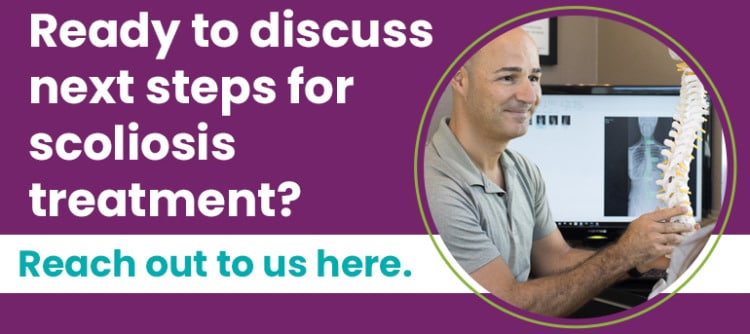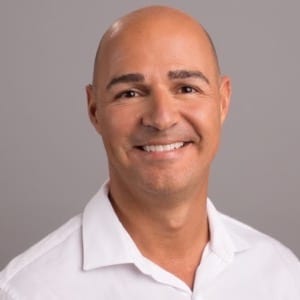What Is Lumbar Scoliosis? A Comprehensive Guide
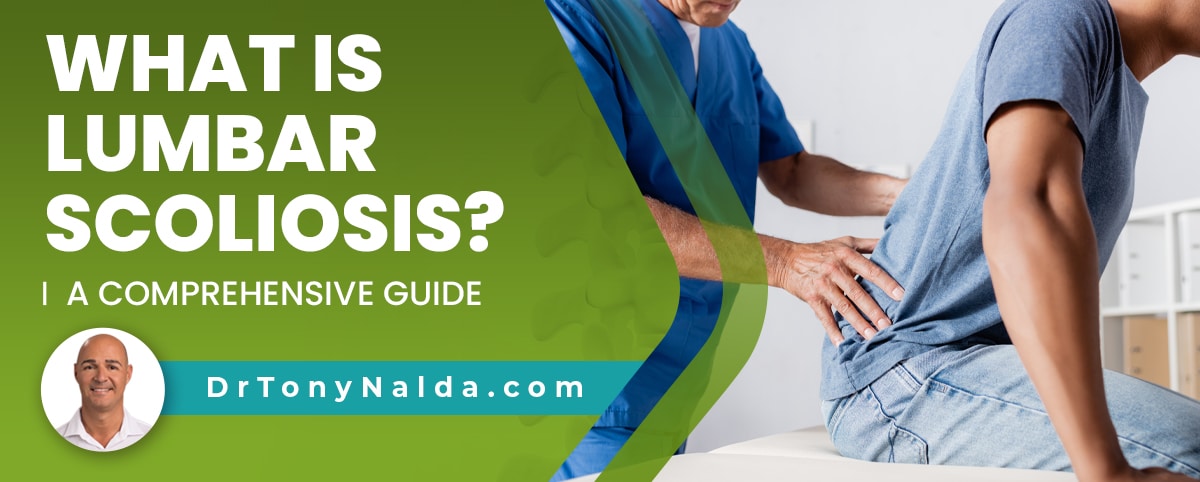
There are many different variables that factor into a patient's experience of life with scoliosis, one of which is curvature location. Where in the spine the scoliosis develops helps predict the types of symptoms a patient is likely to face; in most cases, the area of the body located closest to an affected spinal section is going to feel the majority of its direct effects.
A diagnosis of lumbar scoliosis means an unnatural spinal curve that bends to the side and rotates has developed in the lumbar spine. Scoliosis can develop in any of the main spinal sections, and the lumbar spine is particularly vulnerable due to its flexibility and weight-bearing nature.
As each spinal section has unique roles to play in spinal health and function, let's start with the main responsibilities of each section.
Table of Contents
Understanding the Spine
The spine is one long structure with many moving parts that work together, known as spinal biomechanics.
A healthy spine is necessary for nerve function, mobility, and structural support.
The bones of the spine are known as vertebrae, and in a healthy spine, they are aligned and stacked on top of one another in a straight and neutral alignment, and this also means the spine's healthy curves are in place.
The spine's natural curves make it stronger, more flexible, and better able to absorb and distribute mechanical stress.
There are three main spinal sections: the cervical spine, thoracic spine, and the lumbar spine.
The cervical spine refers to the neck; the thoracic spine includes the middle/upper back, and the lumbar spine refers to the lower back.
The health of each section is dependent on the condition of the other sections, and if a single section loses its healthy curve, the other sections are also affected.
So let's talk about the unique roles of each spinal section.
The Role of the Cervical Spine
The cervical spine acts as the bridge between the brain and the rest of the body.
Remember, the spine works in tandem with the brain to form the body's central nervous system, so spinal conditions can cause a variety of symptoms involving sensation and movement.
The cervical spine has to support the weight of the head, the neck, and facilitates the neck's range of motion.
If the neck's healthy curve is lost, this can shift the head forward, increasing its weight on the cervical spine, known as forward head posture.
A healthy cervical curve is needed for brain-body communication, supporting the weight of the head, and maintaining the neck's range of motion.
The Role of the Thoracic Spine
The thoracic spine is the largest spinal section so is vulnerable to a number of spinal conditions/issues.
The thoracic spine facilitates a lot of the trunk's range of motion and provides structural support for the trunk and abdomen, and as the only spinal section attached to the rib cage, it protects important organs like the lungs and heart.
The Role of the Lumbar Spine
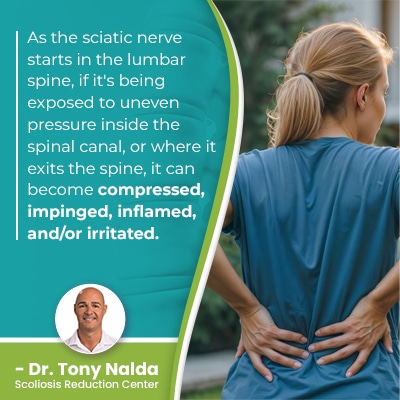 The lumbar spine is also vulnerable to a number of conditions/issues, but for different reasons.
The lumbar spine is also vulnerable to a number of conditions/issues, but for different reasons.
The role of the lumbar spine is to support the weight of the trunk and the spinal sections above, while facilitating a wide range of flexible movement.
The vertebrae of the lumbar spine feel the effects of strenuous movement such as bends, lifts, and twists. It's said that everyone will experience some degree of lower back pain throughout their lives, and it's also said that back pain caused by nerve damage can be the most severe and debilitating.
The health of the lumbar spine will affect lower body movement, and the nerves within play a role in leg movement and sensation.
So what happens when lumbar scoliosis develops and progresses?
Symptoms of Lumbar Scoliosis
If an unnatural spinal curve develops in the lower back, a number of symptoms can develop.
Postural changes are a common effect of scoliosis as the condition's uneven forces disrupt the body's overall symmetry: uneven shoulders, uneven hips, development of a rib cage arch, an uneven waistline, and more.
And in adults, the main sign of scoliosis is pain; scoliosis becomes a compressive condition when skeletal maturity has been reached.
For adults, lumbar scoliosis can cause lower back pain, muscle pain, and pain that radiates into the lower body due to nerve compression.
Sciatica
A common complication of lumbar scoliosis, for example, is sciatic nerve pain.
As the sciatic nerve starts in the lumbar spine, if it's being exposed to uneven pressure inside the spinal canal, or where it exits the spine, it can become compressed, impinged, inflamed, and/or irritated.
Sciatica isn't a condition itself, but refers to symptoms of pain and discomfort felt anywhere along the nerve's extensive pathway.
As the sciatic nerve starts in the lower spine and extends down the back of the hip, buttock, leg, and into the foot, pain and strange sensations can be felt throughout the lower body.
Addressing Lumbar Scoliosis with Treatment
The most important decision to be made following a diagnosis of lumbar scoliosis is how to treat it; different treatment approaches offer different potential results.
And as an ongoing progressive condition, the way scoliosis is treated will shape the spine's long-term health and function.
There are two main treatment approaches for patients to choose between: surgical and non-surgical.
Spinal Fusion Surgery
There was a time when surgery was the dominant treatment choice, but we have since learned that many cases of scoliosis don't need surgery, especially when they are diagnosed early and treated proactively.
As is always the case with surgery, there are risks involved, and when it comes to spinal surgery, considering the many roles the spine plays in overall health, the risks and potential side effects can be severe and should be considered carefully.
Scoliosis surgery is a type of spinal fusion; this approach has the goal of stopping further progression by fusing the most unnaturally-tilted vertebral bodies into one solid bone, and metal rods are attached to the spine to maintain its alignment.
This approach can straighten a bent spine, when successful, but a fused spine is fused for life.
If the procedure is unsuccessful for any reason, or hardware breaks or malfunctions over time, the only recourse is more surgery.
Conservative Non-Surgical Treatment
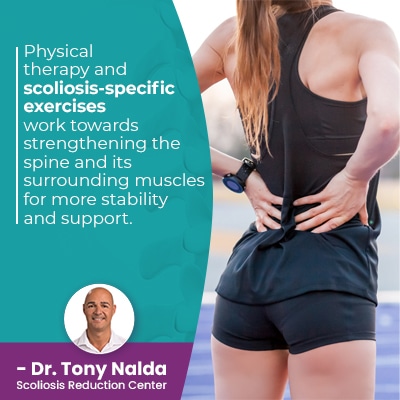 Here at the Scoliosis Reduction Center®, patients benefit from an integrative approach that combines multiple scoliosis treatment disciplines so treatment plans can be fully customized and effective.
Here at the Scoliosis Reduction Center®, patients benefit from an integrative approach that combines multiple scoliosis treatment disciplines so treatment plans can be fully customized and effective.
Chiropractic care, physical therapy, scoliosis-specific exercises, corrective bracing, and rehabilitation complement one another and impact conditions on every level.
As a structural spinal condition, the structural abnormality within the spine has to be impacted with treatment, and this is worked towards through a series of chiropractic techniques and manual adjustments.
Physical therapy and scoliosis-specific exercises work towards strengthening the spine and its surrounding muscles for more stability and support.
Scoliosis is also associated with a muscular imbalance, and physical therapy can work towards improving the balance of the spine's surrounding muscles and improving posture.
A corrective brace is an orthotic device worn around the torso to push the spine into a corrective position, and as growing spines are more malleable, they can be particularly effective in childhood scoliosis treatment.
For treating adult degenerative scoliosis, braces are used for increased stability, curve reduction, and short-term pain management.
Rehabilitation is the ongoing portion of treatment that holds results and continues to heal and stabilize the spine with custom-designed scoliosis exercises.
Conclusion
Lumbar scoliosis needs to be taken seriously, as all condition types do; as a progressive condition, even lumbar scoliosis diagnosed as mild can progress and become moderate scoliosis or severe scoliosis.
Developing scoliosis in the lower back means the lower spine and body are going to be directly affected, and in addition, the spinal sections above can also be impacted.
It's not uncommon for lumbar scoliosis to be the cause of cervical or thoracic scoliosis as the upper spine attempts to counteract the uneven forces of the first unnatural spinal curve with the development of another: compensatory curves.
Lumbar scoliosis can cause postural changes, mobility issues with the lower body, and nerve compression can cause a number of sensations.
The more proactive treatment is, the more successful it's likely to be because it means starting treatment while conditions are at their mildest and likely to be at their most responsive.
When lumbar scoliosis is addressed early in its progressive line, curves can be reduced and postural changes can be addressed; while surgical treatment solely addresses condition effects in the spine, conservative treatment focuses on the spine, its surroundings, and the entire body.
Treating lumbar scoliosis proactively is the best way to minimize the condition's effects, and this is the approach patients of the Center can benefit from.
Dr. Tony Nalda
DOCTOR OF CHIROPRACTIC
After receiving an undergraduate degree in psychology and his Doctorate of Chiropractic from Life University, Dr. Nalda settled in Celebration, Florida and proceeded to build one of Central Florida’s most successful chiropractic clinics.
His experience with patients suffering from scoliosis, and the confusion and frustration they faced, led him to seek a specialty in scoliosis care. In 2006 he completed his Intensive Care Certification from CLEAR Institute, a leading scoliosis educational and certification center.
About Dr. Tony Nalda
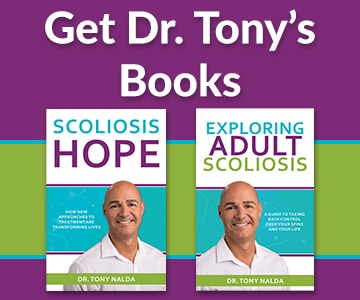 Ready to explore scoliosis treatment? Contact Us Now
Ready to explore scoliosis treatment? Contact Us Now